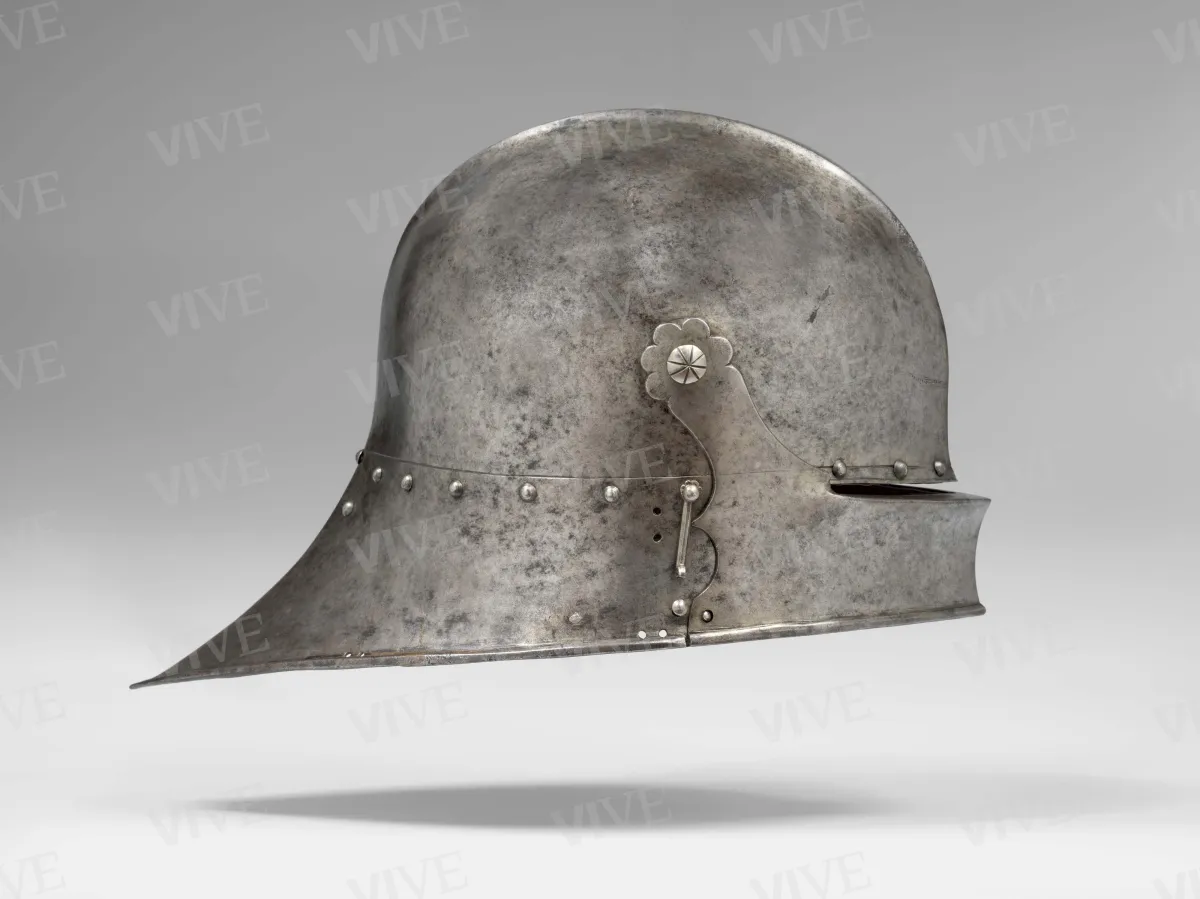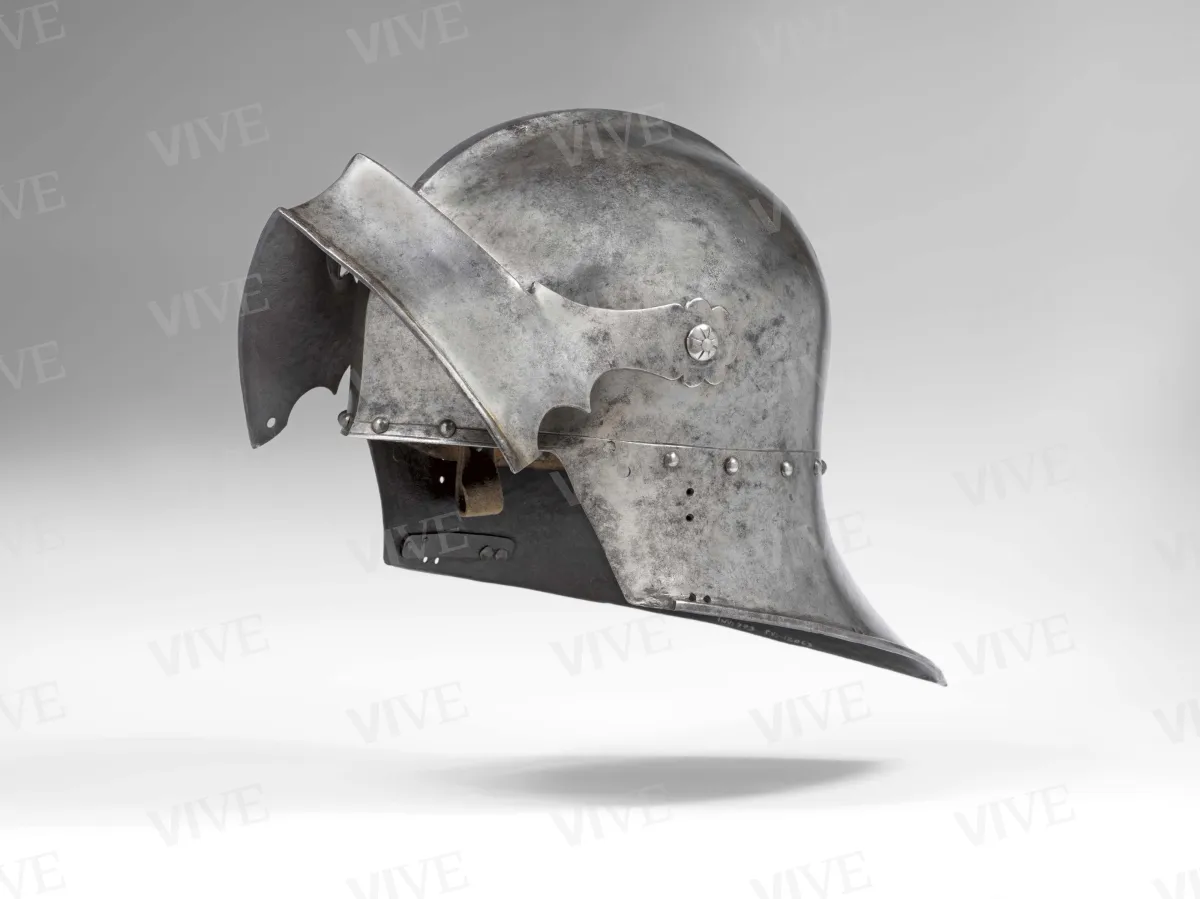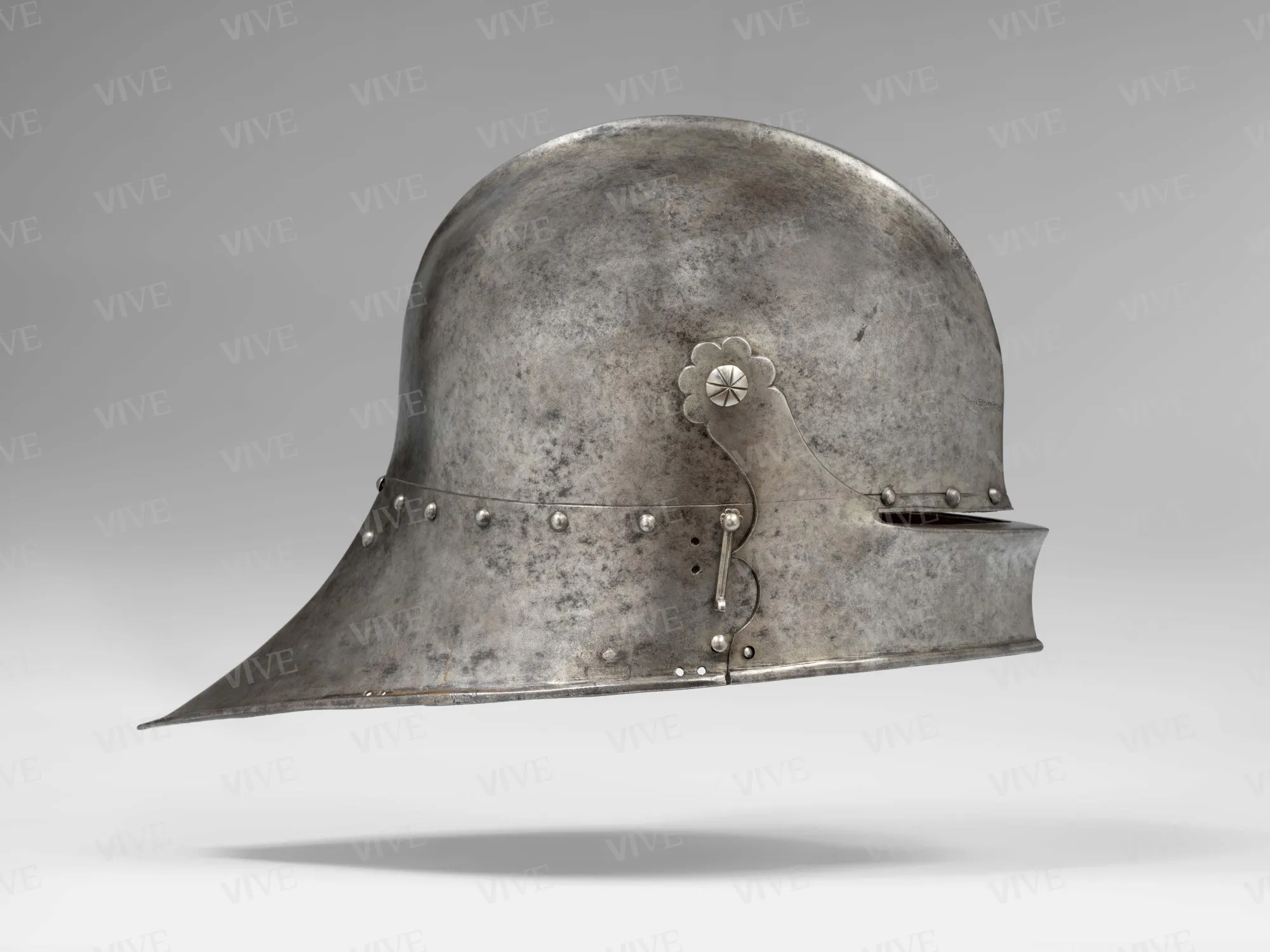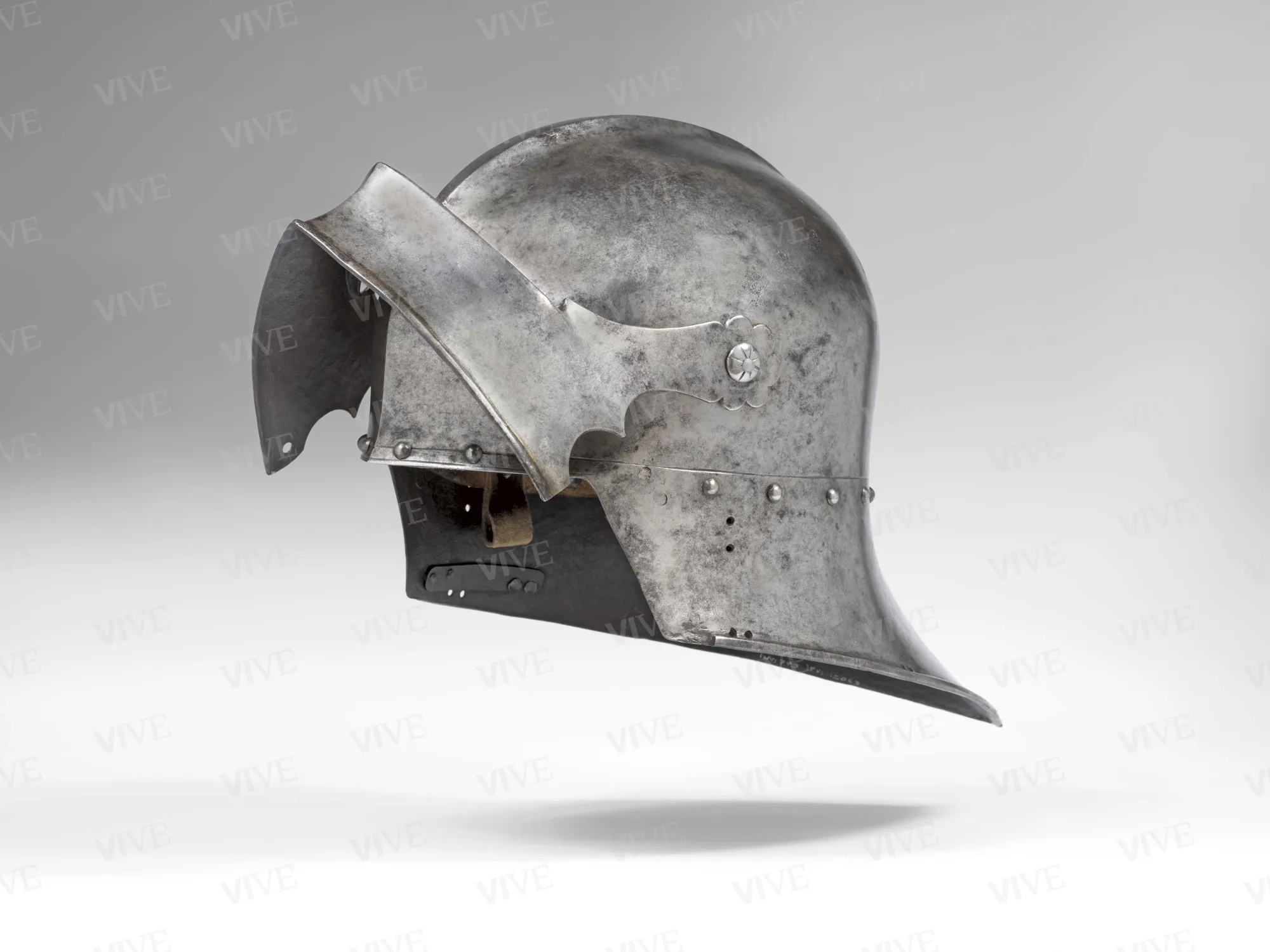Fan-shaped sallet
Workshop of Jörg Wagner 1480–1490
The sallet, a war helmet employed during the fifteenth century, served to safeguard soldiers’ heads. This particular specimen, crafted in Austria, exhibits a straightforward design. It comprises two components: the skull, featuring an elongated point to shield the nape of the neck, and the fan or visor, which could be elevated for practicality or lowered during combat, providing a narrow slit for visibility.
The sallet, a war helmet employed during the fifteenth century, served to safeguard soldiers’ heads. This particular specimen, crafted in Austria, exhibits a straightforward design. It comprises two components: the skull, featuring an elongated point to shield the nape of the neck, and the fan or visor, which could be elevated for practicality or lowered during combat, providing a narrow slit for visibility.
Details of work
Catalog entry
The sallet consists of two distinct components: a hemispherical skull featuring a flattened ridge along its length and an engraved line around its circumference. This line includes at least twenty round rivets (or vervelles) employed to secure the inner lining. The eaves are smooth, elongated, and terminate in a pointed end. The second component, the fan, is affixed to the top with a larger rivet that bears a graphic symbol resembling a sun, with the joint protuberance shaped like a flower. A shaped edge descends from this point, equipped with a catch, and on one side, there is a movable bar ending in a fork on one end and retaining the flower shape on the other. This mechanism allows the visor to be held above the front (di Carpegna 1969, p. 9, n. 30). The artifact is in excellent condition.
The sallet is a type of war helmet that was commonly used across Europe during the fifteenth century, particularly in Germanic regions, as evidenced by numerous armaments depicted in Albrecht Dürer’s engravings. Initially made in the early fifteenth century in simple and functional designs, they attained a high level of aesthetic refinement by the mid-16th century, when notable artists began to craft them (Phyrr 2000). Unlike other types of helmets, which were heavier and bulkier, the sallet lacked both a high crest and a crest (or cimiero), featuring only a straightforward visor that could easily be raised when needed. This design evolved from a type made from a single piece (inv. 12050; Gelli 1900, pp. 81–91; Oakeshott 2012, pp. 109–116).
The helmet shares several characteristics such as the flattened crest, numerous smooth rivets, and the locking bar with examples produced by Austrian weapons maker Jörg Wagner, who was active in Innsbruck between 1485 and 1492. One such example is housed at Churburg Castle in Sluderno, Bolzano province (inv. 62; Thomas, Gamber 1954, plate 16), and another can be found at the Metropolitan Museum in New York (inv. 29.159.5a; Grancsay, Kienbusch 1933, pp. 64–65, n. 4). Although this particular helmet does not bear a workshop mark, it is likely associated with the Austrian arms dealer.
This cuirass was acquired by Prince Ladislao Odescalchi (1846–1922) from the English antique dealer Samuel James Whawell, who also served as an agent for Otto von Kienbusch, whose collection is currently housed in the Philadelphia Museum of Art. Whawell, a personal friend of the prince’s, frequently exchanged letters with him, discussing not only the antique arms market but also their friendship. The cuirass is featured prominently in a photograph published by Stuart W. Pyhrr (1994, p. 16), which depicts the interior of Whawell’s residence in Eastbourne, UK, circa 1905. In the accompanying image, one can identify a breastplate preserved in the Museo di Palazzo Venezia (inv. 12066) and several swords (Barberini 2007, pp. 109–110). Previously, the helmet was part of the collection of the Viennese collector Franz Thill (Lepping 1920–1922, II, p. 33).
Giulia Zaccariotto
Entry published on 27 March 2025
State of conservation
Excellent.
Provenance
Vienna, Franz Thill collection;
Eastbourne, James Whawell collection;
Rome, Collezione Ladislao Odescalchi (Odescalchi, no. 773);
purchased by the Italian State, 1959;
Rome, Museo Nazionale di Palazzo Venezia, 1969.
Exhibition history
Rome, Museo Nazionale di Palazzo Venezia, Antiche armi dal sec. IX al XVIII. Già Collezione Odescalchi, May–July 1969;
Rome, Museo Nazionale di Castel Sant’Angelo; Rome, National Museum of the Palazzo di Venezia; Armi e potere nell’Europa del Rinascimento, July 26–November 11, 2018.
References
Gelli Jacopo, Guida del raccoglitore e dell’amatore di armi antiche, Milano 1900;
Lacking Francis Guy, A Record of European Armour and Arms through Seven Centuries, 5 voll., London 1920-1922;
Grancsay Stephen V., von Kienbusch Carl Otto, The Bashford Dean Collection of Arms and Armor in the Metropolitan Museum of Art, Portland 1933;
Thomas Bruno, Gamber Ortwin, Die Innsbrucker Plattnerkunst, catalogo della mostra (Innsbruck, Tiroler Landesmuseum Ferdinandeum, 1954), Innsbruck 1954;
di Carpegna Nolfo (a cura di), Antiche armi dal sec. IX al XVIII. Già Collezione Odescalchi, catalogo della mostra (Roma, Museo Nazionale di Palazzo Venezia, maggio-luglio 1969), con schede a firma del curatore, Roma 1969, p. 9, n. 30;
di Carpegna Nolfo, Le armi Odescalchi, Roma 1976;
Pyhrr Stuart W., S.J. Whawell and the Art Market, in The Eleventh Park Lane Arms Fair, London 1994, pp. 14-23;
Pyhrr Stuart W, Eurpean Helmets, 1450-1650. Treasures from the Reserve Collection, New York 2000;
Barberini Maria Giulia, La collezione Odescalchi di armi antiche: storia della raccolta del principe Ladislao, in «Bollettino d’arte», s. VI, XCI, 2006 (2007), 137/138, pp. 101-114;
Fossà Bianca, Studio conservativo delle armi e armature Odescalchi. Nuove metodologie per la schedatura di una collezione, in «Bollettino d’arte», s. VI, XCI, 2006 (2007), 137/138, pp. 115-142;
Oakeshott Ewart, European Weapons and Armour. From the Renaissance to the Industrial Revolution, Woodbridge 2012 (I ed. 1980);
Scalini Mario (a cura di), Armi e potere nell’Europa del Rinascimento, catalogo della mostra (Roma, Museo Nazionale di Castel Sant’Angelo; Roma, Museo Nazionale di Palazzo Venezia, 26 luglio-11 novembre 2018), con schede a firma del curatore, Cinisello Balsamo 2018, p. 228, n. VIII.3.














